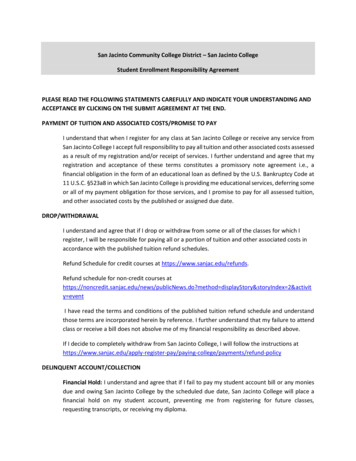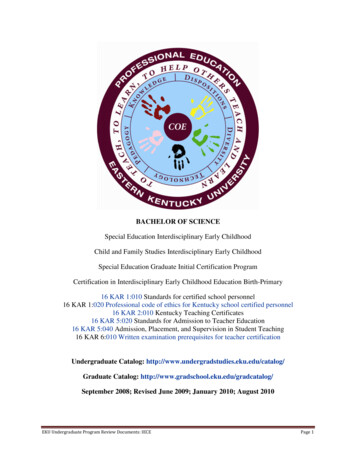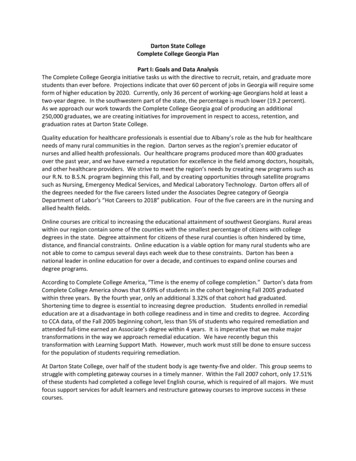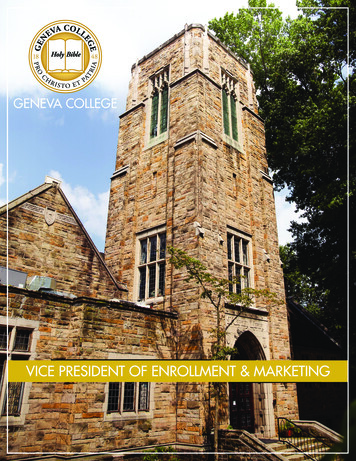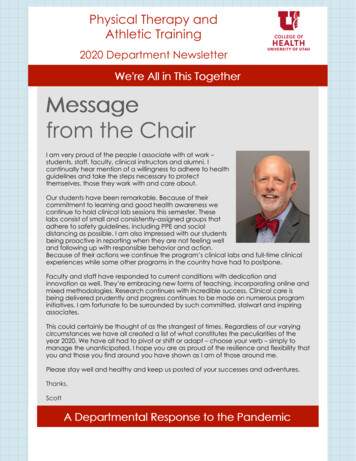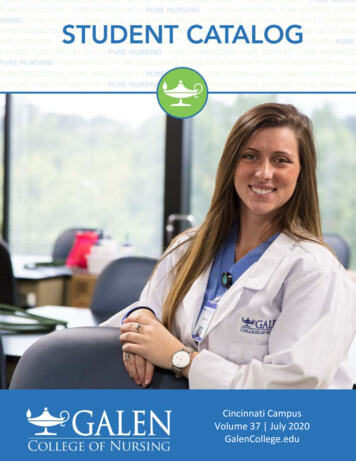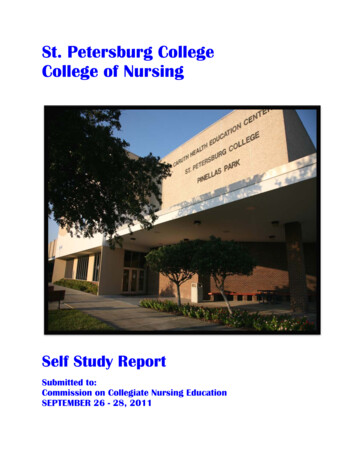
Transcription
St. Petersburg CollegeCollege of NursingSelf Study ReportSubmitted to:Commission on Collegiate Nursing EducationSEPTEMBER 26 - 28, 2011
Table of ContentsBrief Overview of St. Petersburg College Standard I.Program Quality: Mission & Governance I-A .I-B .I-C .I-D .I-E .I-F .I-G .3381113151821Standard II.Program Quality: Institutional Commitment & Resources .II-A .II-B .II-C .II-D .II-E .II-F .23232534363739Standard III.Program Quality: Curriculum & Teaching-Learning Practices III-A .III-B .III-C .III-D .III-E .III-F .III-G .4545475157596162Standard IV.Program Effectiveness: Aggregate Student & Faculty Outcomes .IV-A .IV-B .IV-C .IV-D .IV-E .IV-F .676771767883851
List of TablesTable 1.1Congruency of College and CON MissionStatement and Goals . 4Table 1.2RN-BSN Program Goals in Relation to SPC Goals .Table 1.3All Students Enrolled in the Program 2008 toPresent . 10Table 1.4Expected Faculty Outcomes . 12Table 1.5Policy, Primary Responsibility for Review andLocation of Policy . 18Table 2.1Administrative Support for Students . 31Table 2.2Student Activities at SPC . 31Table 3.1General Education and Support Courses . 53Table 3.2Baccalaureate Curriculum Plan . 55Table 4.1Expected Aggregate Outcomes and Data Sources . 68Table 4.2Respondent and Data Sources . 70Table 4.3Data Review Plan . 72Table 4.4Expected Student Outcomes . 73Table 4.5Demonstrated Achievements: Mean Scores byGroup . 74Table 4.6Exit Exam Results: Mean for RN to BSN students(N) compared to the National Mean . 75Table 4.7Professional Development and Scholarship Data . 855
List of FiguresFigure 1.1Organizational Structure – RN-BSN Program . 14
PROGRAM INFORMATION FORMCommission on Collegiate Nursing EducationOne Dupont Circle, NW, Suite 530Washington, DC 20036-1120GENERAL INFORMATIONOfficial Name of Institution: St. Petersburg CollegeType of Institution (check one):publicprivate, secularprivate, religiousproprietaryInstitution’s Carnegie Classification: Associate's - Public 4-year Primarily Associate'sChief Executive Officer of Institution (Full Name and Title): Dr. William Law, PresidentOfficial Name of Nursing Unit: College of NursingChief Nurse Administrator (Full Name and Title): Dr. Jean M. Wortock, DeanAddress: 7200 66th Street NorthCity: Pinellas ParkState: FLPhone: 727-341-3640Zip Code: 33781Fax: 727-341-3646E-mail address: Wortock.Jean@spcollege.eduWeb site address (URL) of institution: http://www.spcollege.edu/Web site address (URL) of nursing unit: http://www.spcollege.edu/bachelors/nursing/Web site address (URL) of institution’s catalog (if available l/catalog/Web site address (URL) of nursing student handbook (if available electronically):Check here to verify that the Chief Nurse Administrator, identified above, has approved thiscompleted form and confirms its contents as of 08/03/11. (date)1
ACCREDITATION AND APPROVALInstitutional Accreditation:INSTITUTIONAL ACCREDITOR(identify agency name)Southern Association of Colleges andSchoolsLAST REVIEW(year)2008NEXT SCHEDULED REVIEW(year)2018LAST REVIEW(year)NEXT SCHEDULED REVIEW(year)Baccalaureatein Nursing2006Baccalaureatein Nursing2011Master’s in NursingMaster’s in NursingDoctor ofNursing PracticeDoctor ofNursing PracticeBaccalaureatein NursingBaccalaureatein NursingMaster’s in NursingMaster’s in NursingDoctor ofNursing PracticeDoctor ofNursing PracticeSpecialized Accreditation:SPECIALIZED ACCREDITORCouncil on Accreditation of NurseAnesthesia Educational ProgramsAccreditation Commission for MidwiferyEducationCommission on Collegiate NursingEducationNational Association for NursePractitioners in Reproductive HealthNational League for Nursing AccreditingCommissionState Board of Nursing Approval:Name of applicable state board of nursing:NURSING PROGRAM APPROVEDLAST REVIEW(year)NEXT SCHEDULED REVIEW(year)BaccalaureateMaster’sDoctor of Nursing PracticeAdd any relevant comments regarding state accreditation and approval:2
CCNE Program Information FormNURSING PROGRAM INFORMATIONDegree Programs Offered, Student Data:Identify all baccalaureate and master’s degree tracks offered by the nursing unit. For each track, listcurrent enrollment data, as well graduation data for the previous academic year. For thebaccalaureate program, include only nursing students (not pre-nursing students).NURSING PROGRAM(identify all tracks)BaccalaureateGenericRNSecond Career (Fast Track)Other (specify)Totals:NUMBER OFSTUDENTS ENROLLEDNUMBER OFGRADUATES743177743177Master’s(Identify all tracks offered)Totals:Doctor of Nursing Practice(Identify all tracks/majors offered andindicate whether post-baccalaureate orpost-master’s)Totals:3
CCNE Program Information FormIdentify any post-master’s certificate programs offered by the nursing unit:Identify any doctoral degree programs (other than the Doctor of Nursing Practice program) offered bythe nursing unit:Identify any joint degree programs in nursing offered with any other unit at the institution (e.g.,MSN/MPH with the School of Public Health):NCLEX-RN Pass Rates for the Last Three Years (Academic or Calendar):Year# Students TakingNCLEX-RN for 1stTimeNCLEX-RN Pass Rate for1st Time Test TakersNCLEX-RN Pass Rate forAll Test TakersCertification Pass Rates for the Last Three Years (Academic or on Exam(by specialty area)# StudentsTaking ExamCertificationPass Rate4
CCNE Program Information FormNursing Program Faculty:CCNE recognizes that faculty members may teach across program levels. Nonetheless, theinstitution must estimate the faculty full-time-equivalent by program level for the academic year inwhich this form is submitted.Identify the number (headcount) of faculty currently devoted to the nursing unit:# FULL-TIME# PART-TIMETOTAL # FACULTY82533Identify the faculty full-time-equivalent (FTE) currently devoted to the baccalaureate degree program:FULL-TIME FTEPART-TIME FTETOTAL FACULTY FTE1.00.2514.25Identify the faculty full-time-equivalent (FTE) currently devoted to the master’s degree program:FULL-TIME FTEPART-TIME FTETOTAL FACULTY FTEIdentify the faculty full-time-equivalent (FTE) currently devoted to the Doctor of Nursing Practiceprogram:FULL-TIME FTEPART-TIME FTETOTAL FACULTY FTEAdditional Campuses/Sites:Identify any additional campuses/sites where the nursing degree program is offered, the distancefrom the main campus, and the average number of nursing students currently enrolled at eachlocation.CAMPUS/SITE(City, State)DISTANCE FROM MAIN CAMPUS(in miles)# STUDENTSENROLLED5
CCNE Program Information FormDistance Education:Does your nursing unit currently offer curricula (or any part thereof) via distance education (i.e.,alternative modalities, including distance-mediated modalities, other than traditional classroom style)?Baccalaureate (check one):yesnonot applicableIf yes, please provide a brief (one paragraph) description of the distance learning offerings at thebaccalaureate level:The program has a fully online option with 100% of the required courses offered within anasynchronous format that follows the same schedule as the face-to-face classes.There is only one required course in the program that has a lab component: Health Assessment(NUR 3066C). The face-to-face students in NUR 3066C have content in the traditional classroomand do participate in a lab practice. The online students are required to provide documentation offour (4) hours of lab practice either with a nurse practitioner or at one of the scheduled labpractices onsite. Online faculty schedule various practice times at the Health Education Center(HEC) for online students during the semester. Students using both formats have access to avideo clip developed by the lead professor, which demonstrates the total motor exam.If yes, is 50% or more of the required academic credit hours in nursing (excluding practica)accrued through distance education activities?yesno6
CCNE Program Information FormMaster’s (check one):yesnonot applicableIf yes, please provide a brief (one paragraph) description of the distance learning offerings at themaster’s level:If yes, is 50% or more of the required academic credit hours in nursing (excluding practica)accrued through distance education activities?yesnoDoctor of Nursing Practice (check one):yesnonot applicableIf yes, please provide a brief (one paragraph) description of the distance learning offerings in theDoctor of Nursing Practice program:If yes, is 50% or more of the required academic credit hours in nursing (excluding practica)accrued through distance education activities?yesnoAmended August 17, 20097
1St. Petersburg CollegeAccess and excellence are the hallmarks of St. Petersburg College (SPC), founded in1927 as St. Petersburg Junior College (SPJC), Florida’s first two-year institution of higherlearning. SPC is located in Pinellas County, a midway point on Florida’s Gulf Coast bordered bythe Gulf of Mexico on the west and by Tampa Bay on the east. Pinellas County is a peninsula38 miles long and 15 miles wide at its broadest point covering approximately 280 square miles.Pinellas County is part of a four-county metropolitan statistical area referred to as Tampa Bay.Pinellas is the second smallest county in the state and the most densely populated of Florida’s67 counties. Census estimates for 2010 indicate a population of 909,978.Today SPC stands as a multi-campus, two-year and four-year public institution withlearning sites countywide in Clearwater, Largo, Pinellas Park, St. Petersburg, Seminole, andTarpon Springs. More than 63,000 students a year are served by SPC, including students inresidence from several foreign countries. SPC is accredited by the Southern Association ofColleges and Schools (SACS) to award Associate’s and Bachelor’s Degrees. The next formalreview by SACS will be in 2013 as part of the Fifth Year Interim Report with the nextreaccreditation visit in 2018. The RN-BSN Program was initially accredited by the Commissionon Collegiate Nursing Education (CCNE) in April 2007.Dr. Bill Law became SPC’s sixth president on June 7, 2010, following the retirement ofDr. Carl M. Kuttler who served as president for 31 years. SPC has a governing district board oftrustees (BOT) that, according to Florida Statute 1004.65, is the policy making body for theCollege and, therefore, ultimately responsible for ensuring adequate financial resources for theinstitution’s programs. Each SPC campus is governed by a Provost. The College of Nursing(CON) is located at the Caruth Health Education Center (HEC) in Pinellas Park; the Deanreports to the Vice President for the Baccalaureate Programs. The organizational structure ofSPC is found in Appendix A. Institutional goals and initiatives are found in Appendix B andAppendix C, respectively.SPC added baccalaureate degrees to its educational offerings in 2002, becoming thefirst among Florida’s 28 public community colleges to transition to a four-year institution. SPCnow offers 23 bachelor’s degrees, most in areas traditionally underserved by the StateUniversity System (SUS). Following the June 2001 legislation signed by Gov. Jeb Bushenabling SPJC to offer bachelor’s degrees, the SPC dropped Junior from its name but not itscommitment to its two-year mission.
2SPC is a creative leader and partners with students, communities, service agencies,businesses, and other educational institutions to deliver enriched learning experiences and topromote economic and workforce development. The work of its outstanding, diverse faculty andstaff is enhanced by advanced technologies, online learning, international educationopportunities, innovative teaching techniques, comprehensive library and other informationresources, continuous self-evaluation, a climate for student success, and an enduringcommitment to excellence.Academic ProgramsThe nursing program is offered at the HEC in Pinellas Park. SPC offers two nursingprograms, an associate’s degree in nursing (ADN) and a bachelor’s degree (RN-BSN). The RNBSN Program admitted its first cohort of students in August 2002 in response to requests fromarea health care providers for increased opportunities for baccalaureate education in identifieddisciplines of need, nursing being one of the top three. There is no Board of Nursing process forpost-licensure programs in Florida. A notification letter was sent to the Florida Board of Nursingabout the beginning of the RN-BSN program.The CON offers all courses via two delivery options: face-to-face (FTF) at the HEC and online(OL). The students are currently served by eight full-time faculty members with terminal degreesin nursing as well as selected qualified adjunct faculty who possess Master’s of Science inNursing (MSN) and doctoral degrees. The faculty is led by a Dean who also has a terminaldegree in nursing. The CON is served by an advisory board consisting of nurse leaders ineducation, community health and acute care from the Tampa Bay area.As of the spring semester 2011, there were 743 RN-BSN students. The studentpopulation included 621 females (83.6%) and 101 males (13.6%), with 21 students (2.8%) whochose not to disclose their gender. The demographics by race for these students are as follows:American Indian 0.1%, Asian 5.1%, Black/African American 16.8%, Hispanic 6.2%, White67.7%, and Undisclosed 4.0%. The diversity of students in the program by race compares toPinellas County with the following demographics reflective of 2010 County population statistics(data for Hispanic reflects population by ethnicity for the County; other data is by race for theCounty): American Indian 0.3%, Asian 3.0%, Black/African American 10.5%, Hispanic 12.5%,and White 82.1%. As of May 2011, the RN-BSN program has had 844 students graduate withan average GPA of 3.35.
3SELF STUDYStandards for Accreditation ofBaccalaureate and Graduate Degree Nursing ProgramsSTANDARD IPROGRAM QUALITY: MISSION AND GOVERNANCEThe mission, goals, and expected aggregate student and faculty outcomes are congruentwith those of the parent institution, reflect professional nursing standards andguidelines, and consider the needs and expectations of the community of interest.Policies of the parent institution and nursing program clearly support the program’smission, goals, and expected outcomes. The faculty and students of the program areinvolved in the governance of the program and in the ongoing efforts to improveprogram quality.I-A. The mission, goals, and expected student outcomes are congruent with those of theparent institution and consistent with relevant professional nursing standards andguidelines for the preparation of nursing professionals.Elaboration: The program’s mission statement, goals, and expected student outcomes arewritten and accessible to current and prospective students. A mission statement mayrelate to all nursing programs offered by the nursing unit or specific programs may haveseparate mission statements. Program goals are clearly differentiated by level whenmultiple degree programs exist. Expected student outcomes are clear and may beexpressed as competencies, objectives, benchmarks, or other language congruent withinstitutional and program norms.The program identifies the professional nursing standards and guidelines it uses, includingthose required by CCNE and any additional program-selected guidelines. A programpreparing students for specialty certification incorporates professional standards andguidelines appropriate to the specialty area. A program may select additional standardsand guidelines (e.g., state regulatory requirements), as appropriate. Compliance withrequired and program-selected professional nursing standards and guidelines is clearlyevident in the program.Program Response:The mission of the CON and the goals and expected student outcomes (ESOs) for theRN-BSN program are congruent with the mission and goals of SPC and remain consistent withrelevant professional nursing standards and guidelines for the preparation of nursingprofessionals. One mission statement serves the scope of both programs within the CON. TheRN-BSN program differentiates its own program goals and ESOs as appropriate for thepopulation of students it serves.
4MissionTable 1.1 illustrates how the mission of the CON mirrors its parent institution, and thefundamental associations between the two mission statements are italicized in bold print. Bothstatements center on accessible, student-focused educational opportunities reflecting rich andinnovative learning experiences. In addition, SPC’s new president has emphasized studentsuccess as a cornerstone of a formal learning plan, SPC 7/24 Initiative: 7 Major Focuses, 24Observable Projects (Appendix D). The CON mission statement reflects this institutionalcommitment to student success.Table 1.1 Congruence of College and CON Mission Statements and GoalsSPC Mission StatementCON Mission StatementThe mission of St. Petersburg College is toThe College of Nursing at St. Petersburgprovide accessible, learner-centeredCollege is committed to promoting studenteducation for students pursuing selectedlearning and maximizing opportunities forbaccalaureate degrees, associate degrees,student success. Associate andtechnical certificates, applied technologyBaccalaureate level nurses are prepared todiplomas and continuing education within ourcare for a diverse society by exposure to richservice area and globally, while retaininglearning experiences that:leadership as a comprehensive, sustainable, Provide challenging educationalmulti-campus postsecondary institution and asopportunities aimed at developinga creative partner with students,competent nurses who respond tocommunities, and other educationalchanging issues, trends and globalinstitutions to deliver rich learningperspectives; influencing policies andexperiences and to promote economic andpractices in health careworkforce development. Provide a diverse student body withinnovative teaching and learningtechnologies. Enhance opportunities for communitycollaboration and partnerships Contribute to continued commitment tolifelong learning.
5RN-BSN Program GoalsThe program has established three program goals. Although SPC has ten institutionalgoals, Table 1.2 associates RN-BSN program goals with the most relevant goals of the parentinstitution. Both program and institutional goals emphasize lifelong learning including the pursuitof graduate education as well as a focus on the development of breadth and depth ofperspectives.Table 1.2 RN-BSN Program Goals i
Access and excellence are the hallmarks of St. Petersburg College (SPC), founded in 1927 as St. Petersburg Junior College (SPJC), Florida’s first twoyear institution of higher - learning. SPC is located in Pinellas County, a midway point on Florida’s Gulf Coast bordered by the

